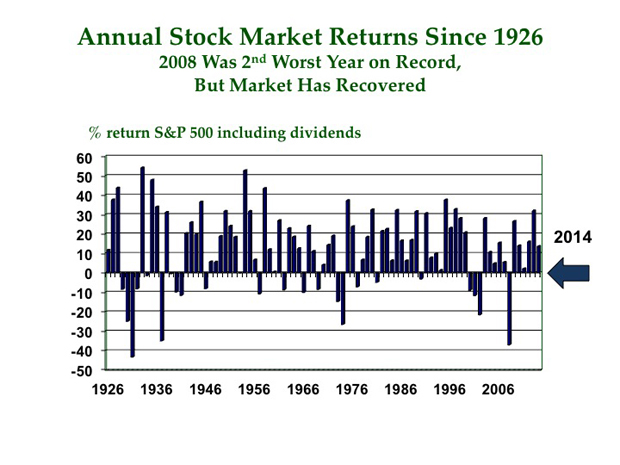Is the market's six-year positive run a new record?
The total return on the S&P 500, including dividends, was 13.7 percent for 2014, the sixth straight calendar year of positive returns since the crash of 2008 and 2009. While that's certainly great news, unfortunately, it's not a record.
The longest run of positive returns for the S&P 500 was nine straight years, from the beginning of 1991 to the end of 1999. The second-longest calendar year streak was eight years, from 1982 to 1989. When you string these two streaks together, you get 17 years of positive returns (separated by just one year -- 1990 -- that saw a loss of 3.1 percent). It's no wonder investors who were active during that time thought the market would always go up.
Prior to the 1980s and 1990s, the winning streak was from 1942 through 1956 -- 13 years of positive returns, punctuated by a loss of 8.1 percent in 1946 and a loss of 1 percent in 1953.
When you look closely at the above chart, you'll see that there are about twice as many up years as down. But that's not the only positive feature of stock market performance; look more closely and you'll see the up bars go up about twice as much as the down bars go down, meaning that when the market went up, you typically made more money than you lost when the market went down.
No doubt you're reading various market prognosticators who are making predictions about the market for 2015, presenting convincing cases that the market will go up ... no wait, it's certain to go down or even crash again! Fortunately, if you're investing for retirement, you can choose to ignore these predictions by allowing your long investing horizon to give you the time you need to ride out the downturns and wait until the market rises again.
If you've already retired, it helps if you have complementary sources of retirement income that don't drop when the market tanks, such as income from Social Security, bond ladders, and guaranteed annuities, which you can use to cover your basic living expenses. This way, when the market drops, you can be assured that you won't need to move in with your kids.
To cover your discretionary living expenses, such as hobbies, travel, and gifts, consider investing the rest of your savings in the stock market to generate a monthly retirement paycheck. Hopefully the above chart will encourage you to remain invested when the market drops and have the patience to wait for the market to bounce back.
There's also plenty of evidence that a low-cost index fund will beat most actively managed funds, so you don't need to fret about finding the best stock market manager. If you can achieve the same return as on the S&P 500, that should be good enough for your retirement stock investments, and you shouldn't need to take additional risks to try to beat the market.
Spend the time necessary to design a thoughtful retirement investing strategy, then go enjoy your life.

